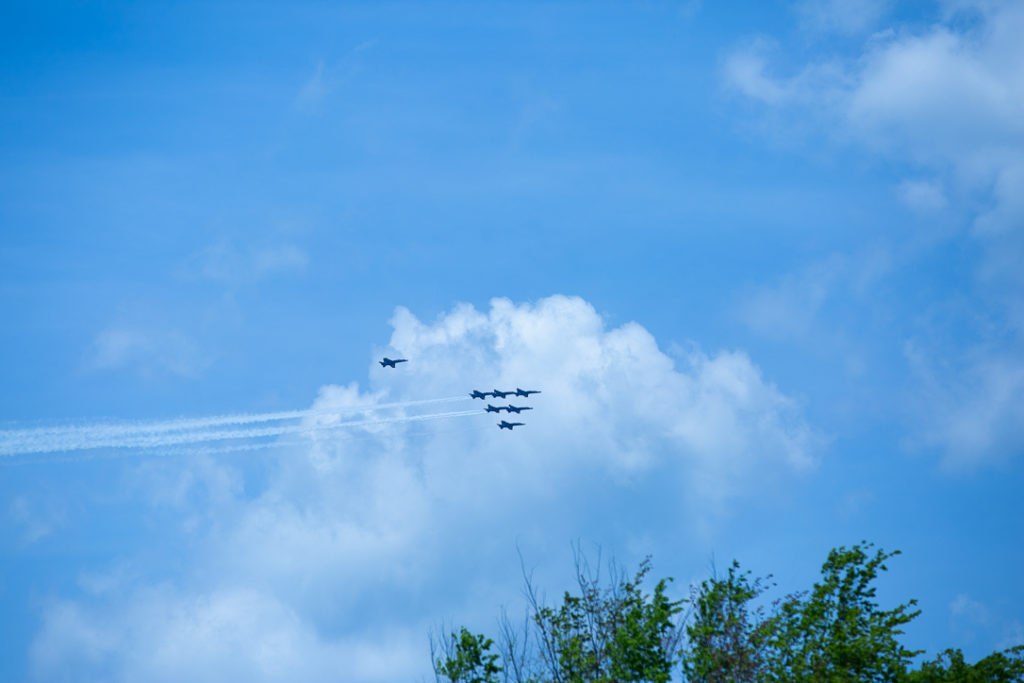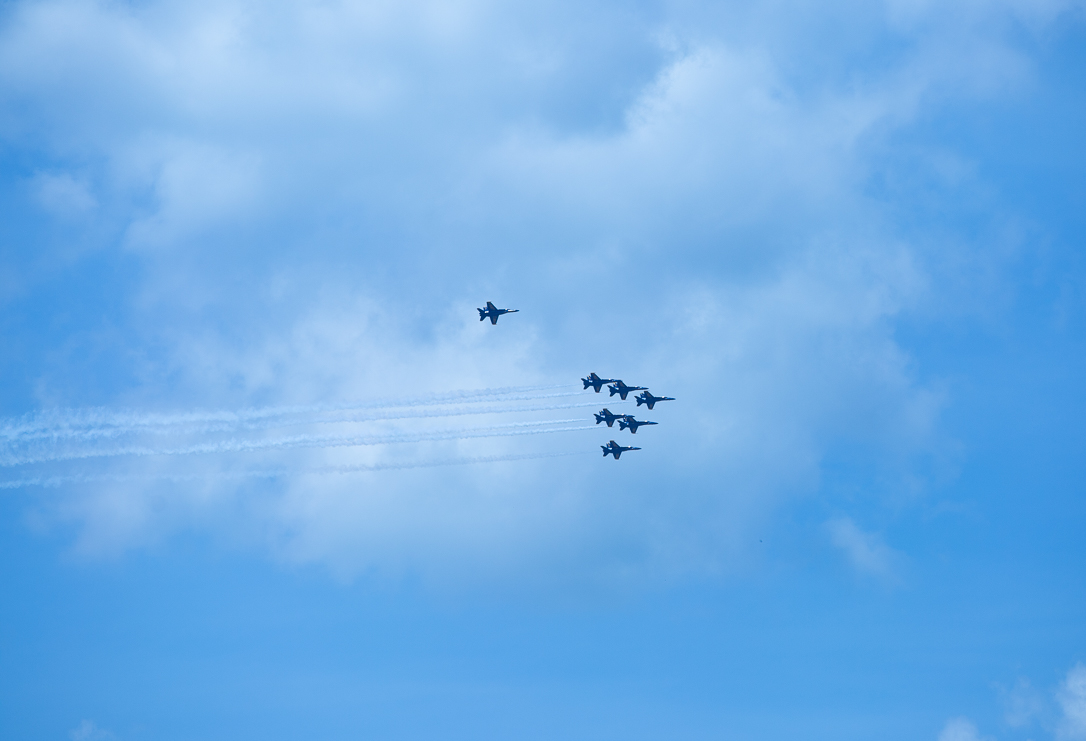Pensacola is one of the best places in the world to visit for any and all fans of aviation history, technology, and aerobatics. After all, Pensacola Naval Air Station serves as home base for the legendary Blue Angels, the elite, long-running flight demonstration team of the U.S. Navy.
From March through November every year, you’ve typically got many chances to see these superb Navy and Marine Corps pilots and their high-performance aircraft in action, whether during weekly practice sessions or a full-on air show.
Here’s a little background information on the Blue Angels—or, as Pensacola calls them, “Our Blues!”
History of the Blue Angels

The Blue Angels trace their history to the immediate wake of World War II, when Admiral Chester Nimitz, chief of naval operations, conceived of a flight exhibition team that could serve to impress and educate the citizenry as well as inspire service members.
The official mission of the Blue Angels is to “showcase the teamwork and professionalism of the United States Navy and Marine Corps by inspiring a culture of excellence and service to country through flight demonstrations and community outreach.”
With the formation of the Navy Flight Exhibition Team, as the squadron was first called, the U.S. Navy introduced only the second such official flight demonstration outfit in the world; it was preceded in 1931 by the French Air Force’s Patrouille de France.
The Navy Flight Exhibition Team debuted on June 15, 1946, at Naval Air Station Jacksonville. The following month, in Omaha, Nebraska, the team performed for the first time as the Blue Angels—a name inspired by a New Yorker column that referenced the Big Apple’s Blue Angel nightclub.
Eight aircraft have served as the official demonstration planes of the Blue Angels over the team’s many decades: the F6 Hellcat, the F8 Bearcat, the F9 Panther, the F9 Cougar, F-11 Tiger, the F-4 Phantom, the A-4 Skyhawk, and—since 1986—the Boeing F/A-18 Hornet, which debuted on the Blue Angels’ 40th anniversary.
These demonstration F/A-18 Hornets have a few special modifications for air-show purposes, but can be converted to combat-ready status within 72 hours.
The Blue Angels team is slated to soon transition to a new flying machine: the Boeing F/A-18E Super Hornet, a larger and farther-flying upgrade to the Hornet.
In addition, the Blue Angels squadron has included a series of support aircraft. Since 1970, its cargo plane has been the C-130 Hercules, fondly known as “Fat Albert” and its own fundamental part of the air shows.
Makeup of the Blue Angels Team
The Blue Angels are comprised of 16 officers of the U.S. Navy and Marine Corps who serve on a volunteer capacity, usually for two or three years, before returning to the fleet. They include demonstration jet pilots, “Fat Albert” pilots, and support officers.
The Blue Angels Commanding Officer, aka “the Boss,” is assigned by the Chief of Naval Air Training and has logged at least 3,000 tactical jet flight-hours and led a jet squadron. The current Blue Angels flight leader is Commander Brian C. Kesselring of Fargo, North Dakota. The Blue Angels Executive Officer (“XO”), also chosen by the Chief of Naval Air Training, is a Naval Flight Officer with at least 1,250 tactical jet flight-hours; the current XO is Commander Todd Royles of Willow Grove, Pennsylvania.
The other tactical jet pilots on the team, who may be from either the Navy or the Marine Corps, also need a minimum of 1,250 tactical flight-hours to qualify and have aircraft carrier qualifications. The C-130 Hercules is piloted and serviced by Marines; the “Fat Albert” pilots have at least 1,200 flight-hours under their belts and are aircraft-commander qualified.
Support positions on the Blue Angels team include Flight Surgeon, Supply Officer, and Public Affairs Officer, among others.
Blue Angels Practices & Shows
Roughly 11 million people view the Blue Angels every year at air shows across the U.S. and in Canada, with more than 50,000 others seeing the team during its annual hospital and school visits.
During the show season, which lasts from March to November, the Blue Angels hold weekly practices out of NAS Pensacola. A fine place to see these practice flights—which usually last about an hour—is at the National Naval Aviation Museum on the base, where bleacher and chair seating are available at the Museum Flight Line. Chair service, concessions, and Blue Angels merchandise are also on hand for purchase during these practice flights, which normally take place at 11:30 AM and are (as you’d expect) subject to weather. Most Wednesday practices are followed by Blue Angels meet-and-greets and autograph sessions at the museum, by the way.
(The National Naval Aviation Museum, meanwhile, is a must-see for Blue Angels fans: Its Blue Angels Atrium displays a formation of vintage demonstration aircraft, while the Blue Angels 4D Experience gives you the illusion of participating in one of these world-famous air shows.)
Another good spot to watch Blue Angels practices? The Pensacola Lighthouse, also situated on NAS Pensacola.
The Blue Angels air shows feature some truly spectacular aerobatics pulled off by jets in formation as well as “Solos.” The Hornets reach speeds of about 700 miles per hour—just shy of Mach 1—during the show’s Sneak Pass routine. Depending on weather conditions, some of the demonstrations may take place as high as 15,000 feet, the altitude at which the Opposing Solo pilot often executes a Vertical Roll. The lowest-altitude routine is that Sneak Pass, which the Head Solo may perform a mere 50 feet off the ground. In the Diamond 360 formation, meanwhile, the Blue Angels jets are a mere foot-and-a-half apart.
The rolls, loops, banks, turns, formation switches, and other maneuvers are made more conspicuous by the trails of smoke issued by the jets: product of a biodegradable, environmentally friendly oil being pumped onto the exhaust nozzles and thereby vaporized.
2022 Blue Angels Schedule
You can keep track of updates and peruse the full season calendar —including scheduled practices and autograph sessions—right here. Currently, scheduled shows in Pensacola include the Pensacola Beach Air Show on July 9th and the Blue Angels Homecoming Air Show at NAS Pensacola on November 11th and 12th.
Whether a practice or an actual show, seeing the Blue Angels in action is easily one of the most unforgettable experiences on the Florida Panhandle: You’ll be rewarded for making the effort to catch one!




